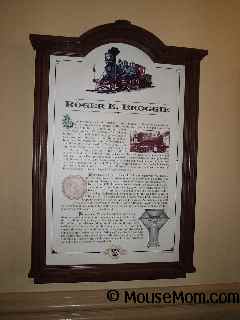
Tips
Contact us
Main Street, U.S.A. | Hub | Tomorrowland | Mickey's ToonTown Fair | Fantasyland | Liberty Square | Frontierland | Adventureland

Picture located under the train station near lockers.
Roger E. Broggie No. 3
Like its counterpart, the Walter E. Disney, the Roger E. Broggie is a ten-wheeler. it has four wheels in the front of the engine, six in the middle and none at the back rear (4-6-0). It came out of Locomotive Works of Philadelphia, Pennsylvania in May od 1925, destined for the jungles of Mexico as engine 275. In 1969, its namesake, Imagineer Roger Broggie, found it discarded and abandoned in the boneyard of a Yucatan railroad equipment storage area. Shortly before his death in 1966, Walt Disney personally authorized the construction of the WDW Railroad for the new theme park he was building in Florida. Roger Broggie suggested using existing narrow gauge steam engines that could be converted to Walt's exacting standards, rather than building new trains, as they had operating in Disneyland. When Roger found what he was looking for in Mexico, he shipped engine number 275 to Tampa, Florida where it was transformed under this direct supervision into the Roger E. Broggie No. 3.
Roger Broggie's career as a railroad man begun with Walt Disney and the planning and construction of the Carolwood Pacific Railroad. Along with Disney studio craftsman Ed Saegent and animators Ward Kimball and Ollie Johnson. Roger helped Walt creates a 1/8 scale, steam train that would travel along 2,600 feet of track around Walt;'s backyard. This miniature railroad served as the model for the Disneyland Railroad and inspiration for the Walt Disney World Railroad. In 1952 Roger Broggie became Walt's first Imagineer and helped develop the technology used for audio- Animatronics and all Disney theme park conveyance systems. Roger returned in 1975 as vice president of research and development for Walt Disney Imagineering, and was recognized by the company in 1990 as a true Disney Legend.
The Rager E. Broggie has what is known as a diamond stack, so named for the shape fashioned at the top of the exhaust track. Very early in the evolution of steam locomotion, it was discovered that smoke was not the only thing exiting the exhaust track. Red hot cinders, particularly adept at the setting of the countryside ablaze, would also blow out. In order to appease angry farmer and town fathers affected by these rolling fine storms, these large stacks were designed with an internal array of baffles and screens that would allow the smoke to pour from the stack, but keep the cinders trapped within.
NOTE: Roger E Broggie got a window on Main Street in Disneyland:
Roger Broggie Shop Master Advisor to the Magic Makers
reported on Magical Definition Podcast on 6-3-07 and 6-10-07, www.magicaldefition.com
Mousemom.com is not affiliated with, authorized or endorsed by, or in any way officially connected with, The Walt Disney Company, Disney Enterprises, Inc., or any of their affiliates. For official Disney information, visit www.disneyworld.com.